SCIN 140
American Military University
All 5 results
Sort by
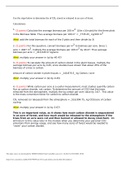
-
Week_5_Trees_and_Carbon_Activity_Sheet_Revised.docx
- Exam (elaborations) • 5 pages • 2022
-
- $10.89
- + learn more
Use the steps below to determine the of CO2 stored or released in an acre of forest. Calculations: 1. (5 points) Calculate the average biomass per 100 m2 (10m x 10m plot) for the three plots in the Biomass Table. Thus average biomass per 100 m2 = _7735.25_ kg/100 m2 (Hint: add the total biomass for each of the 3 plots and then divide by 3) 2. (5 points) For this question, convert biomass per m2 to biomass per acre. Since 1 acre = 4047 m2 , multiply the average biomass per 100 m2 by ...
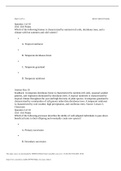
-
Quiz 2 - Lessons 3&4.docx
- Exam (elaborations) • 6 pages • 2022
-
- $10.49
- + learn more
Which of the following biomes is characterized by nutrient-rich soils, deciduous trees, and a climate with hot summers and cold winters? A. Tropical rainforest B. Temperate deciduous forest C. Temperate grassland D. Temperate rainforest Answer Key: B Feedback: A temperate deciduous forest is characterized by nutrient-rich soils, seasonal weather patterns, and vegetation dominated by deciduous trees. A tropical rainforest is characterized by tropical climate throughou...
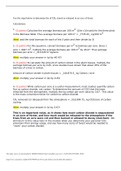
-
Week_5_Trees_and_Carbon_Activity_Sheet_Revised.docx
- Exam (elaborations) • 5 pages • 2022
-
- $10.49
- + learn more
1. (5 points) Calculate the average biomass per 100 m2 (10m x 10m plot) for the three plots in the Biomass Table. Thus average biomass per 100 m2 = _7735.25_ kg/100 m2 (Hint: add the total biomass for each of the 3 plots and then divide by 3) 2. (5 points) For this question, convert biomass per m2 to biomass per acre. Since 1 acre = 4047 m2 , multiply the average biomass per 100 m2 by 40.47. Thus average biomass per acre = _313,045.57 kg/acre (Hint: multiply your answer in (a) by 40...
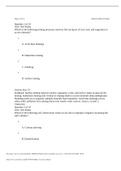
-
Quiz 3 - Lessons 5&6.docx 100% verified
- Exam (elaborations) • 7 pages • 2022
-
- $10.49
- + learn more
Which of the following mining processes removes the top layers of soil, rock, and vegetation to access minerals? A. Acid mine drainage B. Subsurface mining C. Smelting D. Surface mining Answer Key: D Feedback: Surface mining removes surface vegetation, rocks, and soil to create an open pit for mining. Subsurface mining uses vertical or sloping shafts to access minerals deep underground. Smelting melts ore to separate valuable minerals from impurities. Acid mine drain...
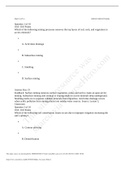
-
AMU SCIN 140 Quiz 3 - Lessons 5&6 Answered
- Exam (elaborations) • 7 pages • 2021
-
- $8.39
- 3x sold
- + learn more
Part 1 of 1 - 100.0/ 100.0 Points Question 1 of 10 10.0/ 10.0 Points Which of the following mining processes removes the top layers of soil, rock, and vegetation to access minerals? A. Acid mine drainage B. Subsurface mining C. Smelting D. Surface mining Answer Key: D Feedback: Surface mining removes surface vegetation, rocks, and soil to create an open pit for mining. Subsurface mining uses vertical or sloping shafts to access minerals deep underground. Smelting ...

Study stress? For sellers on Stuvia, these are actually golden times. KA-CHING! Earn from your study resources too and start uploading now. Discover all about earning on Stuvia


